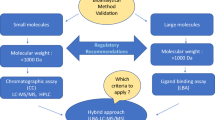Abstract
The L2 Global Harmonization Team on large molecule specific assay operation for protein bioanalysis in support of pharmacokinetics focused on the following topics: setting up a balanced validation design, specificity testing, selectivity testing, dilutional linearity, hook effect, parallelism, and testing of robustness and ruggedness. The team additionally considered the impact of lipemia, hemolysis, and the presence of endogenous analyte on selectivity assessments as well as the occurrence of hook effect in study samples when no hook effect had been observed during pre-study validation.
Similar content being viewed by others
References
FDA. Guidance for industry bioanalytical method validation guidance for industry bioanalytical method validation. Washington, DC; 2001; Available from: http://www.fda.gov/downloads/Drugs/Guidances/ucm070107.pdf
European Medicines Agency E. Guideline on bioanalytical method validation 2011; Available from: http://www.ema.europa.eu/docs/en_GB/document_library/Scientific_guideline/2011/08/WC500109686.pdf
Kelley M, Beaver C, Stevenson L, Bamford R, Gegwich P, Katsuhiko Y, et al. Consensus and recommendation of the L1 Global Harmonization team on run acceptance for large molecule bioanalysis to support pharmacokinetics. AAPS J. 2013;in press.
DeSilva B, Smith W, Weiner R, Kelley M, Smolec J, Lee B, et al. Recommendations for the bioanalytical method validation of ligand-binding assays to support pharmacokinetic assessments of macromolecules. Pharm Res. 2003;20(11):1885–900.
Lee J, Ma H. Specificity and selectivity evaluations of ligand binding assay of protein therapeutics against concomitant drugs and related endogenous proteins. AAPS J. 2007;9(2):E164–70.
Martinez-Subiela S, Ceron JJ. Effects of hemolysis, lipemia, hyperbilirubinemia, and anticoagulants in canine C-reactive protein, serum amyloid A, and ceruloplasmin assays. Can Vet J. 2005;46(7):625–9.
Berube E-R, Taillon M-P, Furtado M, Garofolo F. Impact of sample hemolysis on drug stability in regulated bioanalysis. Bioanalysis. 2011;3(18):2097–105.
Garofolo F, Rocci Jr ML, Dumont I, Martinez S, Lowes S, Woolf E, et al. White paper on recent issues in bioanalysis and regulatory findings from audits and inspections. Bioanalysis. 2011;3(18):2081–96.
Tate J, Ward G. Interferences in immunoassay. Clin Biochem Rev. 2004;25(2):105–20.
Schiettecatte J, Anckaert E, Smitz J. Interferences in Immunoassays. In: Chiu NHL, editor. Adv Immunoass Technol. 2012.
Heidelberger M, Kendall F. Quantitative theory of the precipitin reaction: III. The reaction between crystalline egg albumin and its homologous antibody. J Exp Med. 1935;62(5):697–720.
Gillet P, Scheirlinck A, Stokx J, De Weggheleire A, Chauque HS, Canhanga ODJV, et al. Prozone in malaria rapid diagnostics tests: how many cases are missed? Malar J. 2011;10:166.
Dubois-Galopin F, Beauvillain C, Dubois D, Pillet A, Renier G, Jeannin P, et al. New markers and an old phenomenon: prozone effect disturbing detection of filaggrin (keratin) autoantibodies. Ann Rheum Dis. 2007;66(8):1121–2.
Lu C-H, Kalmar B, Malaspina A, Greensmith L, Petzold A. A method to solubilize protein aggregates for immunoassay quantification which overcomes the neurofilament “hook” effect. J Neurosci Methods. 2011;195(2):143–50.
Wang X, Das TK, Singh SK, Kumar S. Potential aggregation prone regions in biotherapeutic: a survey of commercial monoclonal antibodies. mAbs. 2009;1(3):254–67.
Kozel TR, MacGill RS, Percival A, Zhou Q. Biological activities of naturally occurring antibodies reactive with Candida albicans mannan. Infect Immun. 2004;72(1):209–18.
Lee JW, Kelley M, King LE, Yang J, Salimi-Moosavi H, Tang MT, et al. Bioanalytical approaches to quantify “total” and “free” therapeutic antibodies and their targets: technical challenges and PK/PD applications over the course of drug development. AAPS J. 2011;13(1):99–110.
Talamo G, Castellani W, Dolloff NG. Prozone effect of serum IgE levels in a case of plasma cell leukemia. J Hematol Oncol. 2010;3:32.
Myler HA, Phillips KR, Dong H, Tabler E, Shaikh M, Coats V, et al. Validation and life-cycle management of a quantitative ligand-binding assay for the measurement of Nulojix, a CTLA-4-Fc fusion protein, in renal and liver transplant patients. Bioanalysis. 2012;4(10):1215–26.
Kelley M, DeSilva B. Key elements of bioanalytical method validation for macromolecules. AAPS J. 2007;9(2):E156–63.
Author information
Authors and Affiliations
Corresponding author
Additional information
Guest Editors: Binodh DeSilva and Philip Timmerman
Rights and permissions
About this article
Cite this article
Stevenson, L., Kelley, M., Gorovits, B. et al. Large Molecule Specific Assay Operation: Recommendation for Best Practices and Harmonization from the Global Bioanalysis Consortium Harmonization Team. AAPS J 16, 83–88 (2014). https://doi.org/10.1208/s12248-013-9542-y
Received:
Accepted:
Published:
Issue Date:
DOI: https://doi.org/10.1208/s12248-013-9542-y




